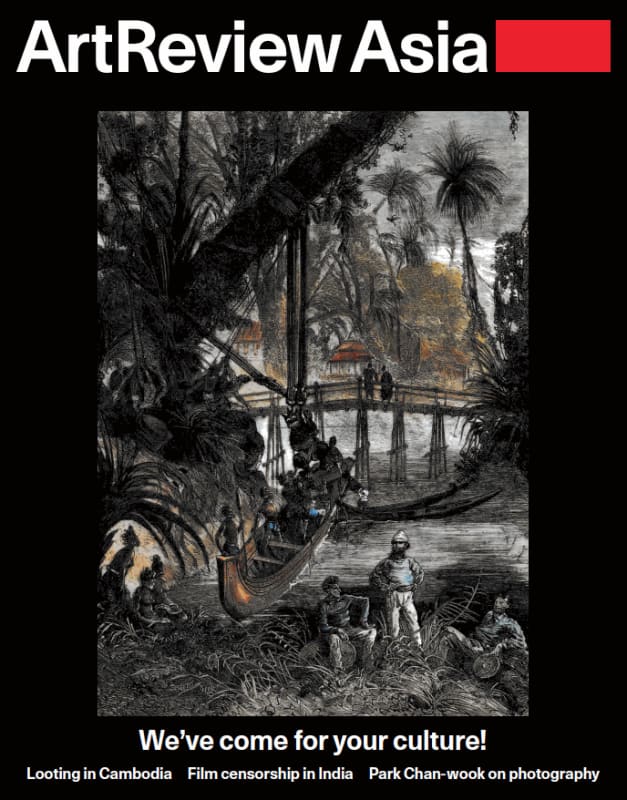This is Yao Cong’s second solo exhibition, five years after the first. If his earlier work explored the body, queer identity and intimacy, this show suggests a break – as if something drastic has happened during this interval, both politically and mentally, on a personal and global scale.
For here, Yao abandons intimacy and individual identity and steps into the wild. And while the blazing, dry and dusty wild of his works can’t be duplicated in the gallery, yellow vinyl sheets applied to the windows create something of an immersive vibe.
The photography series Gold Words (2020), comprises eight shots (spread through the gallery spaces) depicting a mysterious, seemingly naked figure, their prone body covered with a white sheet, at various locations in an unspecified desert or scrubland. On the cloth, which at times (Gold Words #7) appears like a winding sheet that wraps the body, is an embroidered gold sentence that reads, ‘AN ARTIST WHO IS NOT BASED IN THE GOOD PLACE IS NO ARTIST’, the words presumably ring off Mladen Stilinovic’s 1994 banner ‘An artist who cannot speak English is no artist’, which referenced the hegemonic use of English in the artworld, here extended to encompass geography too. Given that Yao’s work eschews any signifiers of a specific place, let alone what might be good and what might be bad, the work begins to resemble something more akin to a scene from a TV crime show, in which an unidentified corpse is found on a long-dried riverbed (Gold Words #4) after an ‘incident’, the body hastily covered to hide the graphic details from passersby (and TV viewers). Yao’s statement raises further questions. Certainly our tendency to look for signs of or associations – like the one just made – with death have become more commonplace since 2020. Still, to pursue the analogy to the crime scene further, the work itself offers little in the way of clues as to what’s going on in this empty land. Is the work then intended as a prophecy or a fable? Linked to the current climate crisis and the political ones that allow it to develop? Or linked to the mental state of the artist themselves? Staring at the luxuriously embroidered golden letters quickly becomes an eerie experience.
The Square Reserve (2020–21) works almost like a response mechanism to a greater trauma. In this ten-channel video, ten different people are shot dancing in the middle of nowhere on a square of fake lawn while listening to their favourite music and drinking beer until they can’t dance anymore. While the actions of these characters might feel normal on a Friday- night in a crowded club, when Yao removes any sense of context, their actions seem both self-destructive and absurd. As the alcohol takes its toll on the participants, they come more to evoke the lonely and isolated inhabitants of old-fashioned asylums. As one of the videos draws to an end, a woman leaves the frame and then yells the artist’s name (he’s not visible on set) in a panic, before mumbling inaudibly.A semifictional setup transformed into a fully realistic offscreen breakdown. All the videos vary in lengths, so each climax comes at a different time. When ten of them are juxtaposed, the ensuing chaos resembles a collective bacchanal. A feast and a tragedy, not in Ancient Greek style, but rather in a form of postapocalyptic hysteria. Or perhaps that’s just the lingering effects of the pandemic talking. In a separate room, the video installation Count (2020) comes with rocks installed on the floor as seating. The yellow-lit room echoes a scene in the video: a woman sitting on a chair in a rocky desert and fiddling her fingers, as if counting imaginary cash. The closeup shots show a twitching performance, like a spasm, or a method practised in Yi Ching to predict the future by counting the knuckles. Seemingly fixated on her nonexistent money, the elegantly dressed woman seems detached from reality and oblivious to her surroundings. Endlessly counting while lacking for herself any sense of past, present or future.
There’s a sense in which Yao’s journey, as depicted in these works, appears both masochis- tic and purposeless. And yet each work evinces a certain sense of commitment and resolve. A journey into the wild. Certainly there is a nod to the ‘retreats’ to which (largely privileged) people resort in order to ‘find’ themselves through isolation or through experiencing something extreme. And indeed there is a sense in which these works perform to cathartic or therapeutic effect. But the experience of seeing them in a gallery, as something that already exists as an interruption to daily realities, makes them feel more like trailers, or rehearsals for something else. A parable perhaps, designed to prepare us for some unnameable future to come.
© ArtReview Asia



